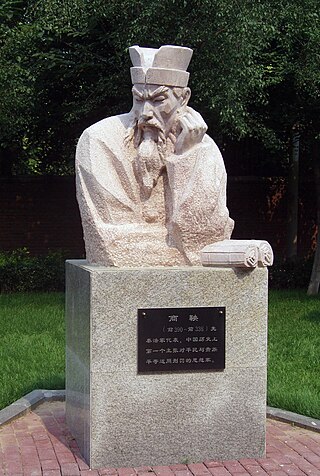
Taoism or Daoism is a diverse philosophical and religious tradition indigenous to China, emphasizing harmony with the Tao—generally understood as an impersonal, enigmatic process of transformation ultimately underlying reality. It is one of the most important ideologies in Chinese thought. The concept originates in the Chinese word Dao 道, whose numerous meanings include 'way', 'road', and 'technique'. Taoist thought has informed the development of practices within the Taoist tradition and beyond, including forms of meditation, astrology, qigong, feng shui, and internal alchemy. Common goals of Taoist practice include self-cultivation, a deeper appreciation of the Tao, and a more harmonious existence. Although diverse, Taoist ethics generally emphasize virtues such as effortless action, naturalness or spontaneity, simplicity, and the three treasures of compassion, frugality, and humility.
In various Chinese religions and philosophies, the Tao or Dao is the natural lessons of the universe that one's intuition must discern to realize the potential for individual wisdom and spiritual growth, as conceived in the context of East Asian philosophy, religion, and related traditions. This seeing of life cannot be grasped as a concept. Rather, it is seen through actual living experience of one's everyday being. Its name derives from a Chinese character with meanings including 'way', 'path', 'road', and sometimes 'doctrine' or 'principle'.

Dao are single-edged Chinese swords, primarily used for slashing and chopping. They can be straight or curved. The most common form is also known as the Chinese sabre, although those with wider blades are sometimes referred to as Chinese broadswords. In China, the dao is considered one of the four traditional weapons, along with the gun, qiang (spear), and the jian, called in this group "The General of Weapons".

Fajia, or the fa school, often translated as Legalism, is a school of mainly Warring States period classical Chinese philosophy, whose ideas contributed greatly to the formation of the bureaucratic Chinese empire, and potentially Daoism, as prominent in the early Han. The later Han takes Guan Zhong as a forefather of the Fajia. Its more Legalistic figures include ministers Li Kui and Shang Yang, and more Daoistic figures Shen Buhai and philosopher Shen Dao, with the late Han Fei drawing on both. It is often characterized in the west along realist lines. With Shang Yang, Shen Buhai and Han Fei taken as a source for Qin dynasty practices by the Han, the Qin to Tang were more characterized by its tradition.

The zhanmadao was a single-bladed anti-cavalry Chinese sword. It originated during the Han dynasty and was especially common in Song China (960–1279).
The Xiantiandao, also simply Tiandao is one of the most productive currents of Chinese folk religious sects such as the White Lotus Sect, characterised by representing the principle of divinity as feminine and by a concern for salvation of mankind.
The Secret of the Golden Flower is a Chinese Taoist book on neidan meditation, which also mixes Buddhist teachings with some Confucian thoughts. It was written by means of the spirit-writing (fuji) technique, through two groups, in 1688 and 1692. After publication of the translation by Richard Wilhelm, with commentary by Carl Gustav Jung, it became modernly popularized among Westerners as a Chinese "religious classic", and is read in psychological circles for analytical and transpersonal psychology considerations of Taoist meditations, although it received little attention in the East.
The Shangqing School (Chinese:上清), also known as Supreme Clarity, Highest Clarity, or Supreme Purity, is a Daoist movement that began during the aristocracy of the Western Jin dynasty. Shangqing can be translated as either 'Supreme Clarity' or 'Highest Clarity.' The first leader of the school was a woman, Wei Huacun (251-334). According to her Shangqing hagiographers, her devotion to Daoist cultivation so impressed a number of immortals that she received revelations from them 31 volumes of Daoist scriptures which would become the foundation of Shangqing Daoism. Later, Tao Hongjing, a man, (456-536) structured the theory and practice and compiled the canon. He greatly contributed to the development of the school that took place near the end of the 5th century. The mountain near Nanjing where Tao Hongjing had his retreat, Maoshan, today remains the principal seat of the school.
Historically, Chinese swords are classified into two types, the jian and the dao. A Jian is a straight, double-edged sword mainly used for stabbing, and has been commonly translated into the English language as a longsword; while a dao is a single-edged sword mainly used for cutting, and has been translated as a saber or a "knife".
The niuweidao was a type of Chinese saber (dao) of the late Qing dynasty period. A heavy bladed weapon with a characteristic flaring tip, it was primarily a civilian weapon, as Imperial troops were never issued it.
Criticism of Buddhism has taken numerous different forms, including philosophical and rational criticisms, but also criticism of praxis, such as that its practitioners act in ways contrary to Buddhist principles or that those principles systemically marginalize women. There are many sources of criticism, both ancient and modern, stemming from other religions, the non-religious, and other Buddhists.
The history ofTaoism stretches throughout Chinese history. Originating in prehistoric China, it has exerted a powerful influence over Chinese culture throughout the ages. Taoism evolved in response to changing times, with its doctrine and associated practices being revised and refined. The acceptance of Taoism by the ruling class has waxed and waned, alternately enjoying periods of favor and rejection. Most recently, Taoism has emerged from a period of suppression and is undergoing a revival in China.
Xuanxue, sometimes called Neo-Daoism (Neo-Taoism), is a metaphysical post-classical Chinese philosophy from the Six Dynasties (222-589), bringing together Taoist and Confucian beliefs through revision and discussion. The movement found its scriptural support both in Taoist and drastically reinterpreted Confucian sources. Xuanxue, or "Mystic Learning", came to reign supreme in cultural circles, especially at Jiankang during the period of division. The concept represented the more abstract, unworldly, and idealistic tendency in early medieval Chinese thought. Xuanxue philosophers combined elements of Confucianism and Taoism to reinterpret the I Ching, Daodejing and Zhuangzi.
The Qingjing Jing is an anonymous Tang dynasty Taoist classic that combines philosophical themes from the Tao Te Ching with the logical presentation of Buddhist texts and a literary form reminiscent of the Heart Sutra. It instructs students of the Tao to practice the elimination of desire in order to cultivate spiritual purity and stillness.

Đạo Mẫu is the worship of mother goddesses which was established in Vietnam in the 16th century. This worship is a branch of Vietnamese folk religion but is more shamanic in nature. Đạo is a Sino-Vietnamese word for "religion," similar to the Chinese term dao meaning "path," while Mẫu means "mother" and is loaned from Middle Chinese /məuX/.

Taoist meditation, also spelled Daoist, refers to the traditional meditative practices associated with the Chinese philosophy and religion of Taoism, including concentration, mindfulness, contemplation, and visualization. The earliest Chinese references to meditation date from the Warring States period.

Taoism is an East Asian religion founded in ancient China with many schools or denominations, of which none occupies a position of orthodoxy and co-existed peacefully. Taoist branches usually build their identity around a set of scriptures, that are manuals of ritual practices. Scriptures are considered "breathwork", that is "configurations of energy" (qi), embodiments of "celestial patterns" (tianwen), or "revelations of structures" (li).

Chinese Manichaeism, also known as Monijiao (Chinese: 摩尼教; pinyin: Móníjiào; Wade–Giles: Mo2-ni2 Chiao4; lit. 'religion of Moni') or Mingjiao (Chinese: 明教; pinyin: Míngjiào; Wade–Giles: Ming2-Chiao4; lit. 'religion of light or 'bright religion'), is the form of Manichaeism transmitted to and currently practiced in China. Chinese Manichaeism rose to prominence during the Tang dynasty and despite frequent persecutions, it has continued long after the other forms of Manichaeism were eradicated in the West. The most complete set of surviving Manichaean writings were written in Chinese sometime before the 9th century and were found in the Mogao Caves among the Dunhuang manuscripts.
Taoist philosophy also known as Taology refers to the various philosophical currents of Taoism, a tradition of Chinese origin which emphasizes living in harmony with the Dào. The Dào is a mysterious and deep principle that is the source, pattern and substance of the entire universe.

Shuitianyi, also known as “paddy field garment”, "Shuitian clothing", or "rice-paddy robe", is a non-religious Chinese patchwork gown which was made and worn by women in China during the Ming dynasty and Qing dynasty; it was made by using many pieces of fabric sewn together ; the clothing reflected the era's tendency towards fashion novelty during the Ming dynasty.








